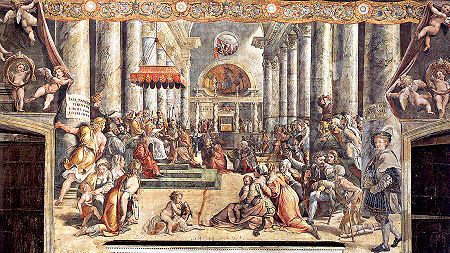The Donation of Constantine (painting)
- The Donation of Constantine (painting)
-
This article is about the painting by students of Raphael. For the forged documents that inspired the painting, see
Donation of Constantine.
The Donation of Constantine or Donation of Rome is a painting by assistants of the Italian renaissance artist Raphael. It was most likely painted by Gianfrancesco Penni or Giulio Romano, somewhere between 1520 and 1524. After the master's death in 1520, they worked together with other members of Raphael's workshop to finish the commission to decorate with frescoes the rooms that are now known as the Stanze di Raffaello, in the Apostolic Palace in the Vatican. The Donation of Constantine is located in the Sala di Costantino ("Hall of Constantine"). It was inspired by the famous forged documents that granted the Popes sovereignty over their territorial dominions.
The painting depicts an apocryphal historical event: Emperor Constantine kneels before Pope Sylvester I and offers the Pope and his successors control of the city of Rome and the entire Western Roman Empire. The depiction of Sylvester is modeled after Pope Clement VII who became pope in 1523.[1] The painting (anachronistically) shows the interior of the original Saint Peter's Basilica,[2] which was in the process of being rebuilt at the time the painting was made. In the center background of the painting is the altar with its twisted, Solomonic columns. These columns were a gift from Constantine who supposedly took them from the ruined Jewish temple.
External links
Wikimedia Foundation.
2010.
Look at other dictionaries:
The Donation of Constantine — Infobox Painting| image size=450px title=The Donation of Constantine artist=Gianfrancesco Penni or Giulio Romano year=1520 1524 type=Fresco height=? width=? city=Vatican City museum=Apostolic Palace The Donation of Constantine or Donation of Rome … Wikipedia
Donation of Constantine — This article is about the forged imperial decree. For the painting by students of Raphael inspired by the decree, see The Donation of Constantine (painting). A 13th C. fresco of Sylvester and Constantine, showing the purported Donation. Santi… … Wikipedia
The Renaissance — The Renaissance † Catholic Encyclopedia ► The Renaissance The Renaissance may be considered in a general or a particular sense, as (1) the achievements of what is termed the modern spirit in opposition to the spirit which… … Catholic encyclopedia
History of the Papacy — The History of the Papacy is the history of both the spiritual role and the temporal role over a timespan of almost 2,000 years from the arrival of Peter in Rome to the present day. The office of the Pope is called the Papacy. In addition to his… … Wikipedia
Timeline of the Roman Catholic Church — As one the oldest branches of Christianity, with Eastern Orthodoxy, [The Eastern Orthodox and some other churches are also apostolic in origin i.e., they also date their origins back to the founding of the Christian Church at the time of the… … Wikipedia
Origins of the Papal Tiara — Pope Innocent III (1198 1216) in early papal tiara, Fresco at the cloister Sacro Speco, about 1219. The origins of the Papal Tiara remain somewhat clouded in mystery. The word tiara itself occurs in the classical annals to denote a Persian… … Wikipedia
Raphael Rooms — The four Stanze di Raffaello ( Raphael s rooms ) in the Palace of the Vatican form a suite of reception rooms, the public part of the papal apartments. They are famous for their frescoes, painted by Raphael and his workshop. Together with… … Wikipedia
Solomonic column — The Solomonic column, also called Barley sugar column, is a helical column, characterized by a spiraling twisting shaft like a corkscrew. It is not signified by a specific capital style and may be crowned with any design, for example, a Roman… … Wikipedia
Christianity — /kris chee an i tee/, n., pl. Christianities. 1. the Christian religion, including the Catholic, Protestant, and Eastern Orthodox churches. 2. Christian beliefs or practices; Christian quality or character: Christianity mixed with pagan elements; … Universalium
Italy — /it l ee/, n. a republic in S Europe, comprising a peninsula S of the Alps, and Sicily, Sardinia, Elba, and other smaller islands: a kingdom 1870 1946. 57,534,088; 116,294 sq. mi. (301,200 sq. km). Cap.: Rome. Italian, Italia. * * * Italy… … Universalium

